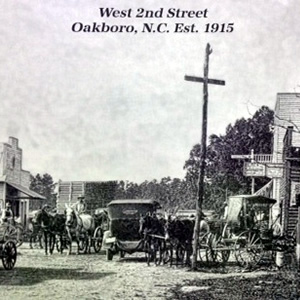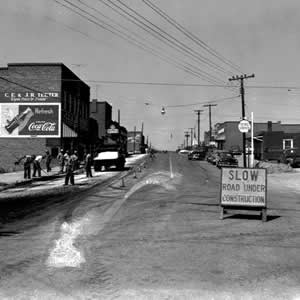- img-01.jpg
Lake at the Park
- img-02.jpg
Oakboro Farmers Market
- img-03.jpg
Small Town Charm
- img-04.jpg
Friday Night Cruise In
- img-05.jpg
Quaint Small Town Shopping
- img-06.jpg
Railroad Museum
Oakboro History
Oakboro traces its beginnings to the coming of the railroad in 1913. Before that time, C.C. Furr’s store and Ellis Thomas’ blacksmith shop were the only evidence of what would soon be a thriving downtown. The first passenger train came through town in late 1913 and stopped at the new Furr City depot.
 In 1915, the name was changed to Oakboro and the town was incorporated. A map of the early town shows a 320-acre tract one mile wide with Main Street running through the center. Furr and other large landowners divided their property into smaller parcels and new homes and businesses began to prosper.
In 1915, the name was changed to Oakboro and the town was incorporated. A map of the early town shows a 320-acre tract one mile wide with Main Street running through the center. Furr and other large landowners divided their property into smaller parcels and new homes and businesses began to prosper.
Oakboro was the center of surrounding rural life, being located at the conjuncture of five roads. In fact, the community was called “Five Roads” for a time prior to the advance of the railroad. Travelers from other communities as well as local farmers regularly used these country lanes to bring cotton, lumber, produce, and other goods to sell or trade for necessities.
With the coming of the railroad, these goods could be moved faster by freight train, and, at one time, Oakboro was known as moving the most freight between Charlotte and Raleigh.
The small town remained relatively unchanged in size for a number of years. More municipal services were added, schools were consolidated, and roads were improved. Business and industry flourished in the early years.
Several cotton gins operated in Oakboro and soon textile mills were added to the landscape. Oakboro Cotton Mill was built in 1923 and brought needed jobs into the area. This mill remained active for nearly 50 years before being sold to Tuscarora Yarns. Today, Tuscarora is the only textile company left and is the town’s largest employer with approximately 200 workers. Most of the local workforce travel to Albemarle, Concord, Charlotte, and elsewhere for their livelihood.
Growth and Expansion
 From its beginnings in 1913, Oakboro town limits remained constant for more than sixty years until annexation began in 1978. From 1960 to 1990, the population remained at approximately 600 and only 64 acres had been added. By 1997, the population had reached an estimated 1,026 and the town was 683 acres. As the Charlotte growth effect became evident, subdivisions have been annexed around the perimeter of the town.
From its beginnings in 1913, Oakboro town limits remained constant for more than sixty years until annexation began in 1978. From 1960 to 1990, the population remained at approximately 600 and only 64 acres had been added. By 1997, the population had reached an estimated 1,026 and the town was 683 acres. As the Charlotte growth effect became evident, subdivisions have been annexed around the perimeter of the town.
The main highway leading into Stanly County from the Charlotte area passes a mere four miles north of Oakboro. The highway has been widened to four lanes and an outer loop around Charlotte had been completed. This improved transportation corridor plus the availability of water and sewer will no doubt bring more people who need housing and other services.
Downtown Revitalization
Downtown Oakboro has been revitalized by the renovation and restoration of buildings erected in the 1920’s and 30’s. Lining Main Street, you will find a museum, old-time hardware store, florist, antique, and gift shops, popsicle factory, hobby, trophy, and consignment shops along with a T-shirt embroidery shop, a mini-park, fresh air market, Town Hall, service stations and excellent restaurants.

